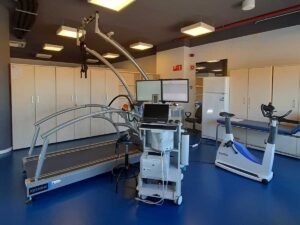Introduction
The aim of this study was to investigate the effects of a six-week low frequency EMS training program on different levels of exercise performance: respiratory, neuromuscular and cardiovascular. Since low frequencies have been suggested to mimic resistance training, we can expect improvements in the subject’s aerobic capacity, fatigue resistance and cardiovascular control. In addition, the results obtained in patients suggest that low frequency training can have significant effects on muscle strength attributable to neuronal and muscular adaptations.
Method
Subjects
A 33 year old man with a previous knee injury participated in this study. The subject led an active life and had never done strength training with EMS.
Study design
The subject underwent 6-week EMS training in the knee extensor muscles of both legs. Four days before the first training session and four days after the last session, exercise capacity, neuromuscular properties, muscle architecture and sympathetic activity were evaluated.
EMS training
The bilateral low frequency training program consisted of a 45 min session, 5 days a week for six weeks. For this, a rectangular wave of 10 Hz frequency was used with a pulse width of 250 μs and with a duty cycle of 9 seconds of work and 2 seconds of rest. The electrodes were placed in the knee extensors (vast medial and vast lateral). The duration of the session was 40 min with a 5 min warm up. The intensity of the EMS was always measured on the maximum tolerance of the subject.
Results
After training, the VO2max was increased by 4.5% and the maximum power by 16.7%. The ventilatory threshold was increased by 11.5%. In terms of muscle adaptations there was an increase in the capacity of maximum contraction and muscle amplitude. In neuronal adaptations there was a 7% increase in voluntary activation levels. There was also an increase in fatigue resistance.
Conclusion
In conclusion, this study is the first to present a summary of the adaptations induced by a short-term low frequency EMS training program. The results confirmed the effectiveness of this training in aerobic capacity, muscle strength and most importantly, beneficial effects on muscle architecture and cardiovascular parameters.
However, caution should be exercised when interpreting these results since the sample in this study is very poor and a low frequency protocol with a larger sample would be required to obtain more reliable results.
Bibliography
Gaëlle Deley and Nicolas Babault (2014) Could Low-Frequency Electromyostimulation Training be an Effective Alternative to Endurance Training? An Overview in One Adult. Journal of Sports Science and Medicine 13, 444-450







